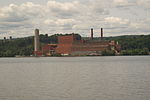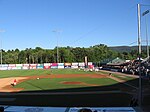Chelsea, Dutchess County, New York
Hamlets in Dutchess County, New YorkHamlets in New York (state)New York (state) populated places on the Hudson RiverPoughkeepsie–Newburgh–Middletown metropolitan areaSource attribution ... and 1 more
Wappinger, New York

Chelsea is a hamlet of the Town of Wappinger in Dutchess County, New York, United States. It is located on the Hudson River in the southwestern corner of the town. It takes the ZIP Code 12512 and is in the 845 telephone area code, and has its own fire district. Chelsea is a small community, primarily residential. A marina is located on the river. Just north of the hamlet is a large pumping station used by the New York City water supply system during droughts to take water directly from the river, since the hamlet is located around the point where the river water becomes fresh enough to drink even in the dryest of times.
Excerpt from the Wikipedia article Chelsea, Dutchess County, New York (License: CC BY-SA 3.0, Authors, Images).Chelsea, Dutchess County, New York
Market Street, Town of Wappinger
Geographical coordinates (GPS) Address Nearby Places Show on map
Geographical coordinates (GPS)
| Latitude | Longitude |
|---|---|
| N 41.553888888889 ° | E -73.968611111111 ° |
Address
Market Street 30
12512 Town of Wappinger
New York, United States
Open on Google Maps







